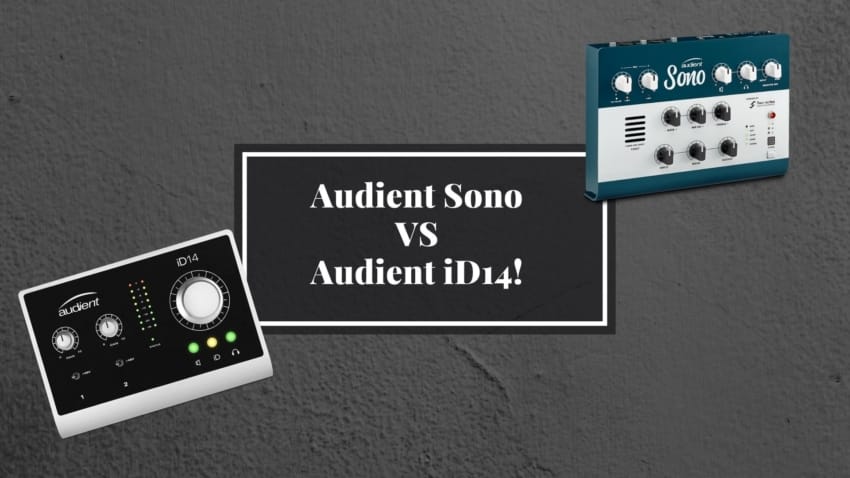Last updated on December 30th, 2023 at 02:47 pm
So, since I moved to another country recently, I had to get rid of all my recording gear and start from scratch.
I was set on purchasing the Audient iD14 but then I noticed the Sono.
Usually, the Audient Sono sells for roughly 50% more than the iD14, but I found it for about $50 more than the iD14 on Amazon and thought I would give it a try.
I ended up returning it and still decided to go for the iD14 instead.
In this post I will give you a complete overview of both the Audient Sono and the Audient iD14 as well as tell you my opinion on which one is overall better.
Related posts:
Basic Differences
The Sono was designed for guitar players since it features a built-in tube preamp and it can be used for reamping, plus it comes with the Two-Notes cab simulation software that runs directly inside of the Sono, allowing for zero-latency recording. The Audient iD14 is a regular Audio Interface that doesn’t have a built-in tube preamp, but it costs a lot less.
Let’s start with an overview the Sono first:
Audient Sono

You probably know this already since you searched for a comparison of the two, but the Audient Sono was specifically designed to be used by Guitar Players.
It comes with a Tube Preamp section that features a 12AX7 Valve/Tube, as well as “Input”, “Drive” and “Output” controls.
Note: No matter how high you turn the Input and the Drive settings, you will only be able to get a slightly overdriven tone.
For high-gain sounds you will need to use an external preamp or pedals.
Additionally, a 3-band EQ with the traditional “Low”, “Mid”, and “High” controls is also available in the preamp section.
All of this allows you to shape the tone of your guitar a bit more than other regular audio interfaces, plus you can use all your pedals to further add effects, distortion, etc., since it really works as a guitar preamp.
If you use the DI input on the front of the Sono, the signal will be sent straight to the valve and into the preamp section.
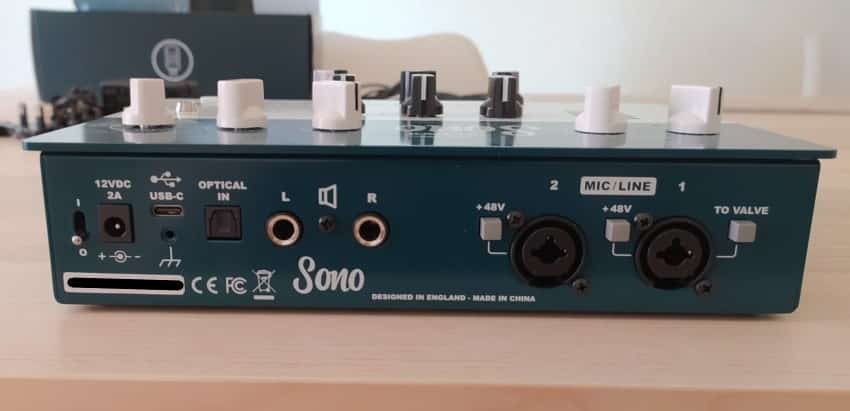
However, it also comes with two additional XLR/TRS combi inputs on the back that can be used to record microphones as well as line level instruments, and these have +48v phantom power switches.
The interesting thing about Input 1 is that it comes with a “To Valve” button that lets you send the signal straight to the Guitar Preamp.
You can use this to add brightness and also warmth to your vocals, or any other thing that you are recording.
In all honesty, I don’t care too much about this feature since I never ended up using it anyway.
Now, one thing I really did like about the Sono is the way the controls are laid out; You have simple knobs that you can turn for each element that you want to control, be it the Headphone Output, Speaker Output, DAW/Input sound blend, etc.
Note: The DAW/Input control lets you choose how much of the Audio that is coming out of your PC vs how much of the direct sound that you are playing can be heard, which lets you record with zero latency.
More on this in a minute since it’s what makes the Sono so special.
Now, in addition to the DI input on the front and the two XLR/TRS inputs on the back, the Sono also comes with an ADAT In port, and this will allow you to connect an external 8-channel preamp, like the ASP 880, to further increase the Input count to a total of 10.
Note: Those 8-channel preamps cost like three times more than the interface itself.
As far as outputs go, the Sono features one Headphone output and one TRS output for each speaker (Right and Left), and that’s really it.
Now, this might not seem as important to most of you, but I think that all Audio Interfaces should have this, which is; An On/Off switch on the back.
The reason I like this so much is because if you need to reboot the Interface because of the driver crashing or anything similar, you don’t need to disconnect the cables.
This is something the Audient iD14 doesn’t have, and I can’t figure out why!
Let’s move on to a very important point, which is;
It still works as a regular Audio Interface
You probably thought that since the Sono is marketed as an Audio Interface for Guitarists, that it would only be able to record the Guitar, right?
Well, that’ not the case.
It’s a 2-input Audio Interface that just happens to have a built-in tube preamp for recording the electric guitar.
But you can multi-track those two inputs to different tracks in your DAW, and if you use an external 8-channel mic preamp, like the Audient ASP 880, then you can actually record 10 inputs to their own tracks.
Now, there was one issue that I had with the Sono that I don’t have now with the iD14, which is that if I have my DAW open, any other sound source, be it YouTube, any media player, etc., doesn’t produce any sound.
The last feature that makes the Sono so special is that it can be used to reamp your sound;
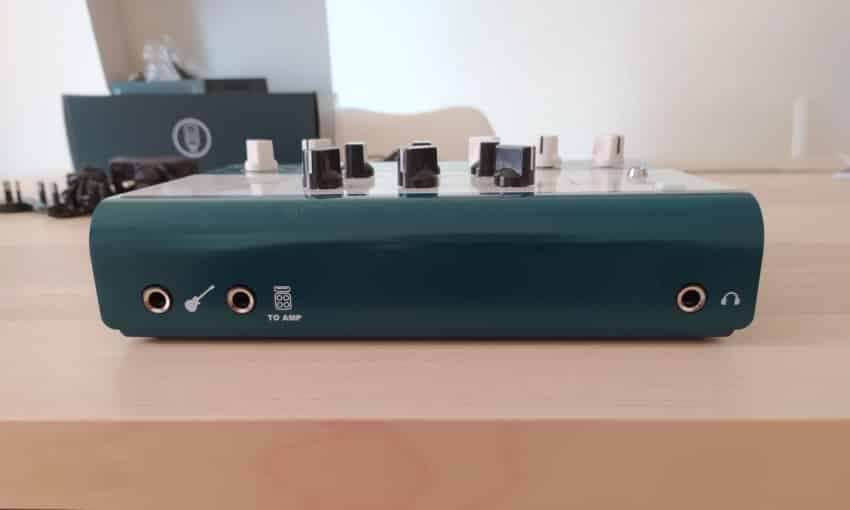
You can record the original signal as well as a dry one to your DAW and then use the dry one to Reamp it later on by using the “To Amp” output on the front.
This will let you record the exact same performance in multiple ways; on different amps, using different pedals, etc.
How does the DI Sound?
Now, the DI sounds pretty good, as it should since it’s an interface designed to record guitar, but I didn’t like the way it sounded once I used software like BIAS FX and Amplitube.
It sounded a lot brighter than I wanted it to, I assume that was because of the valve since I didn’t find a way to bypass it while using the DI input, and ended up having to use the inputs on the back to use those Amp Simulators, which is not ideal.
This is the main reason why I ordered the iD14 and started comparing them directly.
However, the Sono comes with its own software that simulates cabs, which is the…
Two Notes Software

Audient partnered with Two Notes to include a stripped-down version of their cabinet simulation Software in the Sono, which is designed to simulate different guitar cabinets (it doesn’t come with any effects or distortion/overdrive pedals and you also can’t add any in the software itself).
It comes with roughly 20 different cabinet simulations, but you can purchase hundreds more on their website.
Now, these cabs aren’t processed on your PC but rather on the Sono itself, and this means that they won’t introduce any latency, which is why it’s such a great interface for recording (only if you use the Two Notes cab simulation).
If you use Bias FX, or any other amp sim, then the latency will be present since it’s not directly processed on the interface.
You may have noticed that on the top of the Sono there’s a button that lets you scroll through three different cabinets, and these presets can actually be saved, recalled and used at any time, even without even having the Two Notes software open on your PC.
The presets are saved on-to the Sono itself, and the whole idea behind this is that you can use it as a small portable amp in live scenarios; simply connect it to the PA system and that’s it.
How does the Cab Simulation sound?
In all honesty, I played around with this software for nearly a month but didn’t manage to get high-quality sounds out of it.
I always ended going back to Amplitube or BIAS FX, especially since with the Audient drivers I can get the latency down to 1.7ms, which is next to nothing.
I can see the benefit of being able to use it to record with zero latency, as well as having the option to use it to play live or during rehearsals, but it just didn’t sound as I would’ve hoped.
Additionally, even when turning the input and output up as high as possible, the volume that I was able to get wasn’t anything to brag about, but for some reason it started clipping anyway and I had to turn it back down again.
I have to say, it’s definitely not the easiest Interface to wrap your head around since you have to really take your time to get some decent tones out of it.
If you ask me, I’d much rather get a more affordable audio interface and purchase an amp simulation pedal like the Nux Solid Studio.
Build Quality
I definitely can’t bash Audient on this since the Sono is very well built; it’s made of metal, the knobs don’t have that much give to them, and it feels very solid in general.
The only complaint I have is that it gets extremely hot, which I assume it can handle, but it really does get hot.
What comes in the Box?
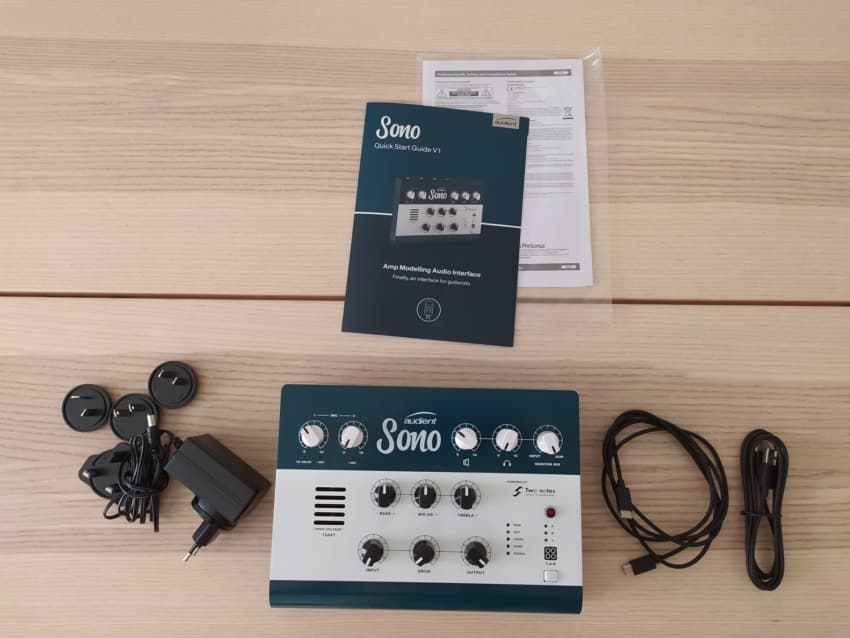
- The Audient Sono Audio Interface
- USB-C to USB-C Cable
- USB-A to USB-C cable
- Power Supply with adapters
Pros
- Good Build Quality
- High-Quality Mic preamps
- Zero-Latency recording
- Guitar Tube Preamp with “Input”, “Drive” and “Output” controls
- “Bass”, “Mid”, and “High” EQ
- Free Two Notes Software included
- Can be used live (Stores cabinet simulation in it)
- Input Count can be expanded to 10
- +48v Phantom Power
- Can be used for re-amping
Cons
- Hard to get good sounds
- Gets extremely hot
- Extra Cabinets cost quite a bit
- It’s quite expensive
Overall, the Sono is a great Audio Interface, plus having the zero-latency feature can come in handy.
Find out more about the Audient Sono here.
- Audient Sono: Amazon, Sweetwater.
Audient iD14
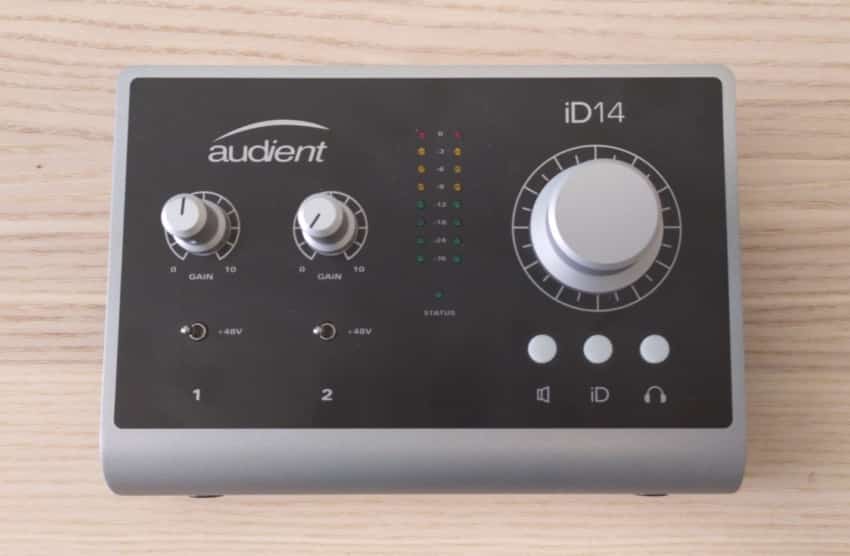
The Audient iD14 is a 2-input audio interface that is considered to be one of the best small-format interfaces out there because of its overall sound quality.
Just like with the Sono, the iD14 comes with an ADAT port on the back that will let you expand the input count from 2 all the way to 10.
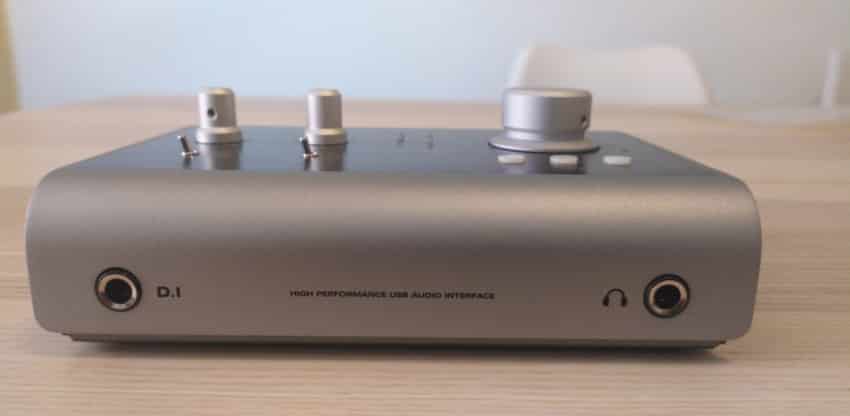
On the front of the Interface you will find the DI input, which is the best-sounding DI I have tried so far, and the Headphone output.
On the back you’ll find the two XLR/TRS combi inputs, the Speaker output, the Optical/ADAT input, and the USB-B port as well as the Power Supply connector.

On the top of the interface are the Gain knobs for Channels 1 and 2, the Phantom Power switches, as well as a big Round Knob with three buttons underneath (Speaker Output, iD Control, and headphone Output).
Pressing the Speaker- or Headphone output buttons will let you use the big knob to control the levels of those outputs.
Now, here is where the iD14 gets interesting; Pressing the “iD” button will let you use the Big Knob to control certain things in your DAW, for example;
You can use it to better control automation by using this knob to increase or decrease the volume in certain parts, etc., instead of having to do it with your mouse.
Here’s a video where you can see it in action:
Side note: The Scroll control can be used in any way you want; I sometimes use it to scroll up and down in my Internet Browser window when I don’t want to use the scroll wheel on my mouse.
Lastly, pressing the Big Knob will mute the sound.
That’s really it for this interface, it doesn’t come with any additional features like the Sono does.
It’s built to do one thing and one thing only; record high-quality audio, and it definitely does this.
Now, I have to say that even though I like that “iD” button that lets you use the big dial to control things inside of the DAW, I prefer having separate knobs for the different outputs, like the Sono does.
It just makes things a bit easier and quicker.
With the iD14, I can’t turn up the speaker volume while simultaneously lowering the volume of the headphones; I need to lower one and then I can turn up the other one.
I know, I’m being extremely picky haha!
Another difference between the two is that the iD14 doesn’t come with an On/Off switch, and if the drivers fail, which doesn’t happen very often, you need to unplug it.
How does the DI sound?
I have to say, this is the best sounding DI I have ever tried, and it definitely sounded better on an amp simulation software than the DI of the Sono.
That’s actually the reason why I first got interested in the Audient iD14, because I watched countless videos of people reviewing it and they all said the same thing about the DI input, and it really does sounds great!
Included Software
Once you register your Audient product, you will get access to some free downloads as well as other special offers.
You can find all of that information here.
I only downloaded the Wall of Sound by Two-Notes, but there are a couple more freebies available.
Build Quality
The build quality is excellent, and I mean EXCELLENT; it’s made completely out of metal, no parts have any give to them and the knobs feel extremely sturdy.
Even though the Sono is well built, the iD14 definitely comes out ahead here.
What comes in the Box?
- The Audient iD14 Audio Interface
- USB-A to USB-B cable
- Power Supply with adapters
Pros
- Extremely well built
- Burr-Brown converters that sound fantastic
- Scroll Control
- Doesn’t get hot like the Sono
- Best sounding DI I’ve heard
- Channel count can be expanded to 10
Cons
- No On/Off Switch
Find out more about the Audient iD14 here.
- Audient iD14: Amazon, Sweetwater.
Differences between the Audient Sono and iD14
The most important difference is that the Sono was designed to record electric Guitar thanks to the built-in tube preamp that lets you control the input level, the drive and the output level.
It also comes with a 3-band EQ to further shape your tone, and it gives you the ability to reamp your sound.
In addition to this, the Sono comes with the Two Notes cab simulation software that lets you load cabinets directly on-to the Sono, which means that not only can you use it live, but also to record without any latency whatsoever.
However, if you want to use any other Amp Simulation software like BIAS FX, it won’t sound as good since the DI signal is being sent through the valve first.
Other than that, both Audio Interfaces feature two inputs that can be expanded up to 10 via the Optical input on the back, and the mic preamps really do sound fantastic.
Which one do I recommend?
Well, I personally prefer the Audient iD14 mostly because it’s more affordable, even though I managed to get the Sono for a lot less than the original asking price.
I paid about €250 for the Sono and roughly €180 for the iD14.
I know that in the US the Sono usually sells for over $400 and the iD14 for about $300.
Now, even though I really liked the Sono, I sent it back because it wasn’t working for me; I expected it to sound fantastic with the Two-Notes software, yet I always ended up using other Amp Simulation software instead.
And even then, the DI input on the iD14 made the amp sims sound a bit better than what I was able to get with the Sono.
Additionally, the Sono had way more driver issues and I had to constantly turn it off and back on, and even though it can do zero-latency recording while using the Two-Notes software, I can run BIAS FX at 1.7ms of latency which I don’t even notice, and the sound ends up being better.
This is why I actually prefer and also recommend the Audient iD14; It’s more affordable, doesn’t get hot at all, less driver issues, etc.
Conclusion
Both Audio Interfaces are great, but they serve a different purpose.
Overall, considering the price, I prefer the Audient iD14, plus the build quality is way better and it should last you longer.
I hope this information was useful!
Have a wonderful day!
